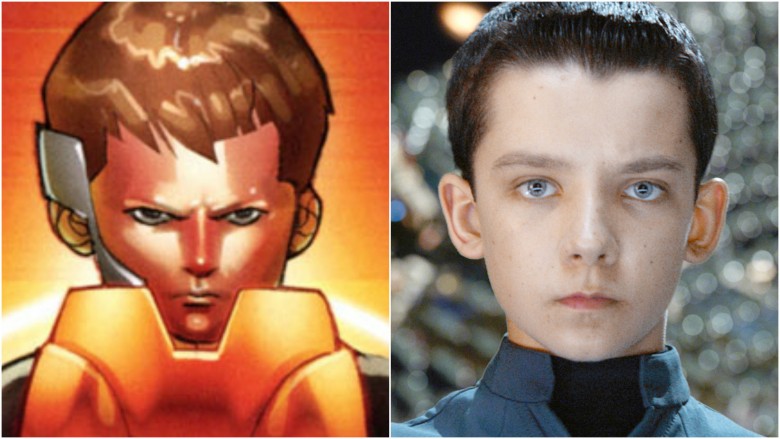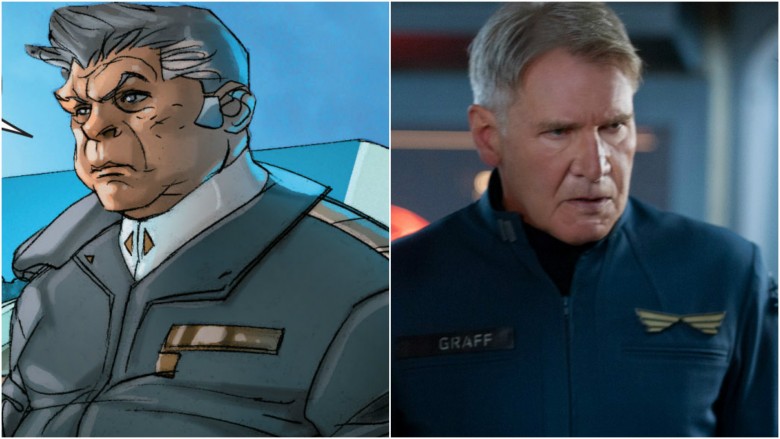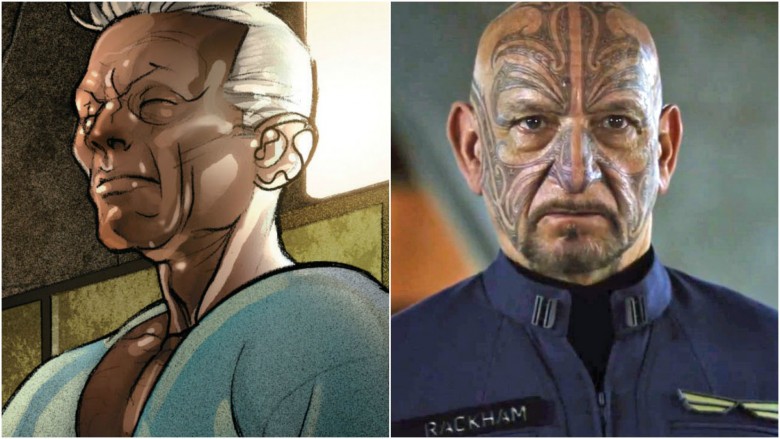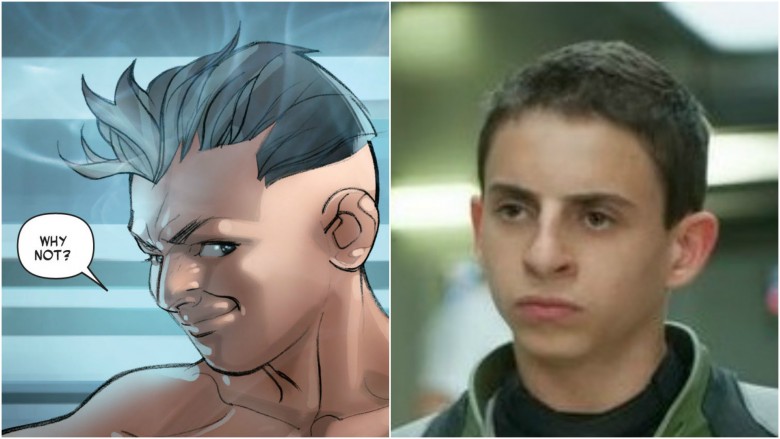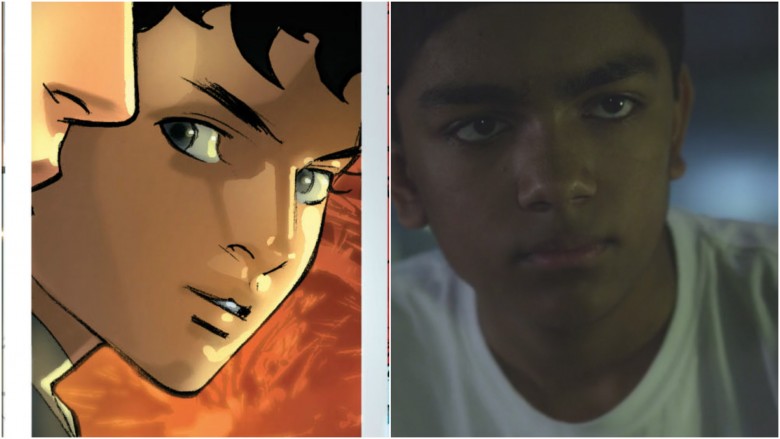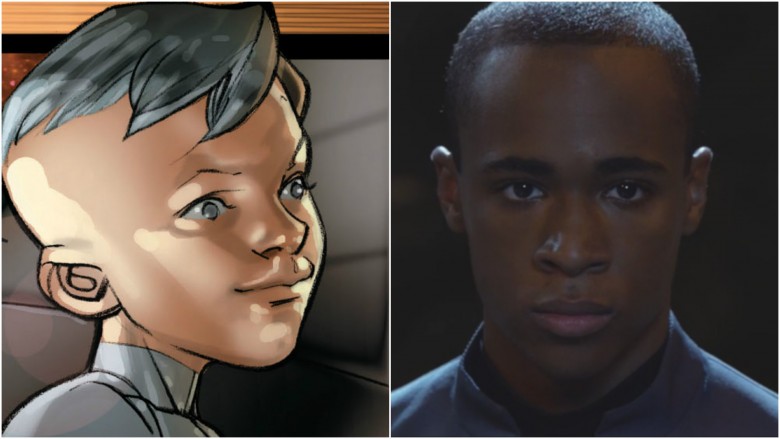How The Cast Of Ender's Game Should Really Look
A lot of people had trouble sitting down in theaters to see Ender's Game. After all, it's hard to get comfortable in such tiny seats with so many big expectations. Despite boasting more stars than the Battle Room and the promise of a visual spectacle sprung straight from rich decades inside adolescent imaginations, Ender's Game landed clumsily in theaters, sprained its ankle, and limped along ever afterward.
Or did it? Once you put on the rose-colored glasses of nostalgia it's hard to take them off, and we all spent so much time picking away at the changes from the beloved novel that most of us forgot to just enjoy it as a movie and ... OK, it's not exactly creme de cine in that light, either. There was plenty of room for improvement, especially with the characters. Here's how the cast of Ender's Game should really look.
Ender
Asa Butterfield does an admirable job of bringing Earth's greatest military mind to life on the big screen as Ender Wiggin. He's tough and intelligent, with enough empathy to make him the perfect cocktail of Valentine's kindheartedness and Peter's ruthlessness. But while Butterfield displayed the right chops in the acting department, he was completely wrong for the part.
In the book, the events of the story stretch over nearly six years. Ender is 6 years old when he's taken to the Battle Station and 11 by the time he goes to Command School to fight the buggers (sorry, Formics). Asa Butterfield was 16 at the time of the movie's release. So right off the bat, you have to take 10 years off Butterfield to get an idea of Ender's true size. On top of that, Ender is small for his age–a vital detail in the scenes where Ender ruthlessly takes out his larger, stronger enemies. The point is for him to out-think them, not be evenly matched in size and strength. It's hard to imagine that Ender's life is in any serious danger when he fights Bonzo Madrid in the shower–he stands a full foot taller than the guy. In the book, however, Ender has to leap off the ground just to ram his head into Bonzo's nose.
Ender is also seriously worn out by the end of Command School. After months of constant "games," he can barely eat, collapses from exhaustion in the middle of a battle, and spends five days after beating the buggers practically comatose: "The days wore on, with battles every day, until at last Ender settled into the routine of the destruction of himself. He began to have pains in his stomach. ... 'Eat,' Mazer said, and Ender would mechanically put food in his mouth. But if nobody told him to eat, he didn't eat." The movie, however, barely brushed the surface of how close Ender actually came to killing himself through sheer exhaustion.
On a lighter note, while Orson Scott Card never gives Ender much of a physical description, the 2008 graphic novel adaptation of the story shows Ender with sandy blond hair cut short, but not in a military buzz the way it was in the films.
Movie accuracy: 4/10 — It's downright tough to cast a 6-year-old as a child genius ... but it's not that hard to find a wig.
Colonel Graff
As far as personality goes, Harrison Ford was the perfect casting choice for Colonel Hyram Graff. The movie shows him as a tough mentor constantly pulling the strings to turn Ender's life into a living hell in an effort to bring out the boy's full potential–exactly as Graff is portrayed in the novel (although not quite as tough).
Physically, though, the movie could have added a few pounds to his character. Literally. His main characterization? Fat and getting progressively fatter throughout the story. Remember, the arc of the novel takes place over six years, and in Graff's own words, "When I'm tense, I eat." So periodically throughout the novel, we see a character commenting on Graff's blossoming waistline. From the book:
"Her last doubt was removed when she saw the soft-bellied man in the uniform of an I.F. colonel sitting in the one comfortable chair in the room."
"Graff sat at his desk, looking fatter and wearier than the last time Ender had seen him."
"His belly spilled over both armrests now, even when he sat upright."
For Harrison Ford to properly portray Colonel Graff, he would have needed a good 40 pounds extra added to his frame–a far cry from the rugged good looks of Old Man Solo.
Movie accuracy: 7/10 — Honestly, does anybody really want to see an overweight Harrison Ford anyway?
Mazer Rackham
Let's go ahead and get this out of the way: in the book, Mazer Rackham's face is not covered in tribal tattoos. However, it does make sense, since Rackham is part Maori, a culture known for exactly that type of full-body inking. As the book describes him: "It was Mazer Rackham, a little-known, twice-court-martialled, half-Maori New Zealander whose Strike Force broke up and finally destroyed the bugger fleet in the action around Saturn."
Coupled with Ben Kingsley's New Zealand accent, the film painted a pretty accurate picture of Mazer Rackham's background. That said, it wouldn't have been far off the mark to stick an extra 20 years on the guy, either. As described when Ender first meets Rackham:
"He looked to be about sixty, by far the oldest man Ender had seen on Eros. He had a day's growth of white whiskers that grizzled his face only slightly less than his close-cut hair. His face sagged a little and his eyes were surrounded by creases and lines."
In other words, Rackham should have at least been older than Colonel Graff, who is by far the oldest man in the entire movie. But other than that, and the odd-but-understandable decision to paint up his face, Rackham comes across pretty well as described in the book.
Movie accuracy: 6/10 — Considering that Rackham's age was pretty damn vital to the story, we'd hoped for a little more accuracy here, mate!
Bonzo
Moises Arias brought all kinds of cruel intensity to the character of Bonzo Madrid, the hardass, impetuous commander of Salamander Army. His mentality–so consumed by honor that he's willing to kill to protect his integrity–is spot-on. Unfortunately, his physical appearance leaves a lot to be desired. For starters, he should have been much, much bigger. If Ender is a foot taller than he should be in the movie, then Bonzo should have been two feet taller ... and maybe a little more handsome. When Ender first walks into the Salamander barracks, this is what he sees: "A boy stood there, tall and slender, with beautiful black eyes and slender lips that hinted at refinement."
Later, when Ender kills Bonzo in the shower, the size discrepancy is even more pronounced: "He began to take off his uniform. 'Naked and wet and alone, Ender, so we're even. I can't help that I'm bigger than you. You're such a genius, you figure out how to handle me.'"
Movie accuracy: 5/10 — Bonzo loses major points for his height. All five, in fact. Everything else was rock solid.
Bean
If any character in Ender's Game got the full onscreen treatment, it was Bean. Described as smaller than Ender, impetuous, and fiercely intelligent (in fact, the parallel story Ender's Shadow pins him as the only kid smarter than Ender), Bean was just as sharp and ornery as he needed to be onscreen. But if you had to push for changes, he probably could have had fairer skin and a Dutch accent, considering that he was born in Rotterdam, in the Netherlands. But even the graphic novel ignored all that, so that's cool. In the end, Aramis Knight's take on Ender's street-smart, smart-ass sidekick was well-informed enough to satisfy most fans of the book (even if the movie took out, like, all his cool parts).
Movie accuracy: 10/10 — Look at those pictures! Even his expression is pluperfect perfection. Rock on, Aramis. Rock right on.
Alai
In both the book and the film, one of Ender's first real friends at Battle School is Alai, played by Suraj Partha. Throughout the story, Alai comes to be Ender's right-hand man in the battles, sticking with him all the way through the ultimate battle against the buggers in the finale. As portrayed in the movie, Alai is Muslim, although the book never says exactly what country he comes from. Not that it matters–in a future where all religions are suppressed, the mere act of whispering the word "Salaam" to Ender is a show of solidarity and friendship. Like Bean, Partha's onscreen portrayal of Alai was pretty well pitch-perfect.
Movie accuracy: 10/10 — And finally, a kid in this movie who actually looks like a kid!
Petra
The first time Ender meets Petra Arkanian in Salamander Army, he mistakes her for a boy: "Now another boy joined the conversation, a smaller boy, but still larger than Ender." He initially thinks she's Bonzo, but Petra corrects him with a snide, "No, just a brilliant and talented polyglot. Petra Arkanian. The only girl in Salamander Army. With more balls than anybody else in the room."
The description doesn't go much further than that, but it reveals at least two things about Petra: First, like everybody else, she's bigger and older than Ender. Second, her hair is cut short just like everybody else's in Battle School. Hailee Steinfeld's on-screen ponytail and dimples were nowhere in the picture. And not to keep beating a dead cat, but 17-year-old Hailee Steinfeld was still way too old to play an androgynous girl who's closer to 8 years old in the story.
Movie accuracy: 6/10 — The movie took a lot of liberties with Petra, both in looks and personality. And that romance vibe between her and Ender came way out of left field. Like, out of the stadium left field, like maybe it had been waiting under someone's Dodge Charger in the parking lot, crouching, watching everyone who came late to the ballgame. Who knows. It was weird, is what we're saying.
Dink
Epic though it may be, Orson Scott Card's original novel is still more whitewashed than Tom Sawyer's clapboard fence with all the racist undertones of a Nascar-themed cross burning. Even the non-American characters tend to be white non-Americans, like the Dutch Bean and the fair-skinned Spaniard Bonzo, so it's understandable that the movie made some more modern casting decisions. For example, Dink Meeker, who came from a "home in the Netherlands, with three generations under Russian hegemony"–deep in the Caucasus–is played by African-American Khylin Rhambo in the film. And Rhambo nailed the part as Ender's mentor and eventual friend. Sure, he could have been taller. Dink once said that Ender could "walk between my legs without touching my balls," but at some point you've gotta accept that nobody was the right size or age, so other than that Dink looked and acted the part perfectly.
Movie accuracy: 8/10 — A minor character from the start, Dink did all the things Dink needed to do. Good job, Dink.
Valentine
One of the major changes in the movie was the complete removal of Valentine and Peter's subplot. You know ... the really important one where they take over Earth. As a result, Abigail Breslin's Valentine gets precious little screentime, acting only as a shoehorned moral anchor for Ender's internal struggle while the source material devotes multiple chapters to Valentine's story arc as Demosthenes, her alter-ego who shapes the course of Earth's politics. She's careful, calculating, and calm. Even in the scene at the beginning where Peter threatens to kill Ender, Valentine doesn't bawl and bang on the door–she coldly explains why killing Ender wouldn't be in Peter's best interests, convincing Peter to stop choking his little brother to death on the bedroom floor. It's a whole family of frigid little geniuses who don't behave anything like children.
Like most of the major characters, Orson Scott Card never explicitly describes Valentine's looks in Ender's Game, although the graphic novel adaptation gives her shoulder-length blonde hair rather than the long, auburn locks seen in the film.
Movie accuracy: 7/10 — Change her hair, feed her a spoonful of extra empathy, and you've got yourself a Valentine Wiggin.
Peter
If the movie cut out most of Valentine's characterization, it straight up neutered Peter's, leaving him only as an image that pops up whenever Ender needs to feel sorry for himself. The end of the book, of course, situates Peter as the new ruler of Earth after the old political order breaks down following Ender's destruction of the bugger species. Along the way, we get plenty of glimpses of both Peter's cruelty and genius, all the features the movie hints at but never really describes.
For starters, blond-haired Jimmy Pinchak should have gotten a dye job: "Ender did not see Peter as the beautiful ten-year-old boy that grown-ups saw, with dark, thick, tousled hair and a face that could have belonged to Alexander the Great." Ender learns to watch Peter's eyes for signs of impending violence, and the characterization only deepens throughout the book. Peter tortures animals, manipulates everyone around him–including his own parents–and burns for power, yet can still come to Ender in the middle of the night when he thinks everyone's asleep and tell him he loves him, words unheard by anybody except him. Instead of all that, we got a cartoon cutout of a bullying older brother who then neatly goes away for the rest of the movie. Oh well.
Movie accuracy: 2/10 — With his brief minute of loud, shoutey screentime, Peter was arguably the least faithful adaptation of any creature ever put onscreen, and that's counting all the dinosaurs in Jurassic Park III.

